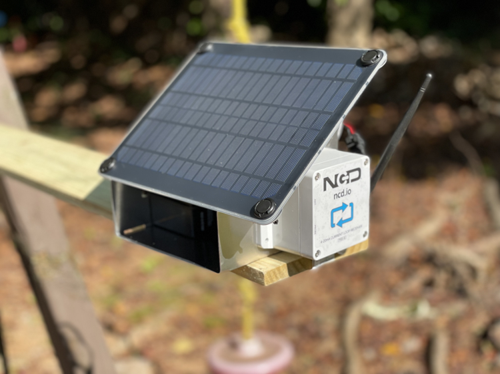I’ve had a field failure of a 4-20mA Current Loop Receiver.
It is dead and does not power up on external power or AA batteries.
We’re running a trial on a few devices and I’m trying to figure out what went wrong.
-It is hooked up to a Vega radar sensor. That unit is still fine. It powers up and runs no problem.
-The external power wires of the NCD unit were connected in parallel to a small solar panel and an Interstate 12V 6Ah AGM battery.
The idea was to use the solar panel and battery combination to extend the operating life. Our radar needs several seconds of power up and is kind of power hungry. We also want a reading every 10 minutes, so the AA batteries weren’t going to cut it. It ran fabulously for about a year, then abruptly stopped. Working through possibilities.
-Ingress Protection failed on the NCD unit and shorted something? I have the cable gland model before the m12. It was not a great seal, but I RTV’ed to help. But, it’s still not great.
-Solar panel failed from …too much sun and shorted bringing down the battery (but NCD unit would normally still work)
-Battery failed? But how could that fail the NCD unit?
Would you’all be able to take the unit back and give me a post-mortem of what died and why?
The solar panel is dead and has no output, but is not shorted
The battery went to near zero volts and is also dead, but is not shorted.
The NCD unit is dead, but not shorted.
Should I just mail it back to your attention?

For ref: pic of box with solar panel, radar gauge and battery.
Label faded completely in sunlight exposure, unfortunately.
Was just taking a look before I sent it to you. I can see the solder mask discolored and one of the pins on an IC is damaged. I think the regulator blew, if that’s the chip right there. Maybe the gland failed. Going to button it up then submerge it and see if it leaks water in just for my hypothesis test, then will send
Interesting, the power jumper connection to the lid had some corrosion/damage. I submerged the unit while watching it (to the edge) and the RTV’d gland held. So it does look like it failed dry.
I did leave the batteries in there even though I had the switch in the (left-off) position. Could having the batteries installed, the switch turned off, and an external power supply smoke that IC (guessing regulator)? Will be in the mail to you’all shortly. THANKS! Appreciate anything you can do to help me figure out if this is a bad luck rarity or something I can prevent. I’ve been on your side of the emails for other sensor/device companies for many years, so appreciate you looking into this.
looks like there is a lot of corrosion there.
One key point – the lid looks square but it’s rectangular. so if it was not screwed in correctly moisture or water can get in through the lid.
It was dry when I opened it. Did you’all get a chance to analyze it? I sent it back.
i will take a look at it next week
Hello Scott,
I had the opportunity to investigate the matter you mentioned. It is evident that the unit has suffered significant water damage, with the power supply being the point of failure. The switching power supply was unable to maintain a constant 3.3V, and I suspect this may be due to a short circuit caused by rust accumulation. Fortunately, the radio module and the CPU are still functioning properly. However, the ADC (analog-to-digital converter) has also been damaged.
To address this issue, we will develop a new unit with an M12 connector. The M12 connector will serve as the interface for both signal and power connections.
In terms of power supply, we have been experimenting with rechargeable battery designs. It is worth noting that more than 90% of our clients use these devices in indoor industrial environments, so we have never had a requirement for solar-powered options.
Please let me know if there is anything else I can assist you with.
Thanks! When I opened it, there wasn’t any water in it. but I didn’t have enough room to point the cable gland down–so was certainly a weak point. It was outside in Georgia so did get a heat endurance test also. Your label also isn’t weatherproof. The serial number faded so much as to be unreadable after a year of sun exposure. Great to hear about the solar option. It gets you from a “change the batteries” option to a “run forever option.” Keep up the good work.
We have been using weatherproof stickers for a while now. It also has a QR code which consists mac address and other metadata (user-specific).



